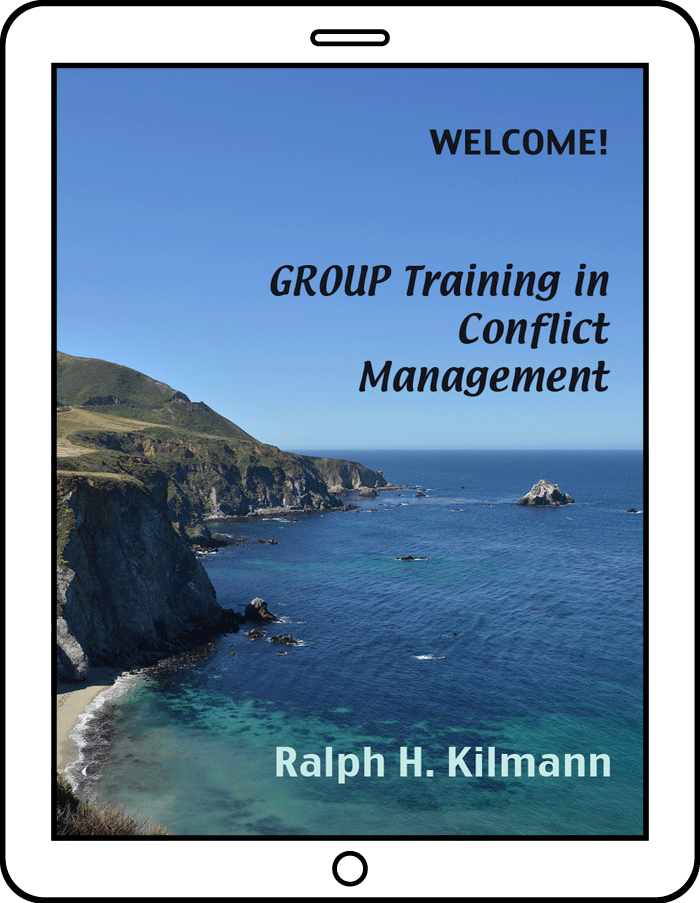
How to combine this online course with live discussions
The members of the same work group (whether a department, task force, project group, cross-functional team, or process improvement team) will gain extra benefits from taking any of our online courses AS A GROUP. Rather than members of an organization taking our online courses separately and thus independently, learning key principles and practices with your workplace colleagues will not only enhance what every member learns from our online courses, but will also make it much easier to apply what is learned back on the job—where it counts.
Basically, when all group members (1) learn the same language and the same concepts, (2) review the same assessment tools and their personalized results, (3) analyze and discuss the same business cases, and (4) follow the same guidelines for effective behavior—BECAUSE all these principles are fully shared in the group, they are more likely to be put into practice when challenging problems and conflicts appear in the workplace.
On this page, I outline how a work group can take full advantage of all the valuable materials in GROUP Training in Conflict Management. The unnumbered paragraphs describe what members are asked to do on their own, such as watch the course videos, take assessment tools, or complete work sheets in their course manual. Meanwhile, the numbered paragraphs provide the detailed steps for learning the material through face-to-face or virtual group meetings. Depending on the unique circumstances and needs of each group, this process for blended learning can be adjusted or expanded.
THE DETAILED STEPS
Before beginning the GROUP course, each member should take a pair of TKI Assessments, each with modified instructions:
1. INSIDE your group, how do you usually respond when you find your wishes differing from those of another group member?
2. OUTSIDE your group (across all other settings in your life), how do you usually respond when you find your wishes differing from those of another person?
When members are about to take the TKI assessments, instruct them to IGNORE the standard TKI instructions that appear on their computer screen or Internet tablet. Instead, they should keep in mind the modified instructions for each TKI (and the members of their group) as they respond to all 30 A/B items on the assessment.
On their own, group members watch the first few video sections, covering pages 1 to 26 in the Course Manual for GROUP Training in Conflict Management. Afterward, the group holds a sixty-minute meeting to discuss these numbered paragraphs:
1. Discuss all the distinctions in the Complex Hologram, as they specifically pertain to the topic of this course: The Individual (what each person brings to the group in terms of styles, skills, and conflict-handling modes); The Organization (the formal systems that shape their group’s behavior); CULTURE (the unwritten rules that dictate “how things are done around here”); and The Group (how the members manage their daily stream of problems and conflicts, making use of their individual styles and skills, as shaped by their organization’s strategy-structure, reward system, and those unwritten cultural rules). Members should also discuss how all these interrelated aspects determine whether their organization can effectively respond to The Setting, which ultimately produces The Results.
2. Either the group performs a self-diagnosis of the effectiveness of its conflict-handling behavior or an external consultant (a trusted member from the HR department or an outside consultant) performs an independent diagnosis. This “conflict management diagnosis” is conducted through one-on-one interviews with members and/or through a group interview with or without the immediate boss present—based on the prior assessment (see my earlier discussion) on whether the group’s culture would allow for an open and candid dialogue with the boss present. Regardless of how the diagnosis is conducted, however, it’s important to establish whether conflicts among the members are being approached according to the specific guidelines on pages 11 to 18 in the manual. Basically, the diagnosis stipulates if the group is already handling its conflicts in an effective manner or, instead, if significant improvement in conflict management is necessary before members can fully contribute their wisdom and experience to their most important problems and conflicts. Incidentally, this diagnosis will be used in subsequent steps to select specific action recommendations to implement, once the Group TKI Profile has been developed and interpreted.
3. Discuss the difference between the standard TKI instructions and the modified TKI instructions, the latter having guided how members responded to the TKI on two different occasions: the initial TKI assessment for INSIDE the group and the second TKI assessment for OUTSIDE the group (across all other settings in a person’s life).
4. Discuss the various factors that determine if there are similarities or differences between a member’s INSIDE and OUTSIDE results across those two TKI assessments. Refer back to the Complex Hologram and all those interrelated forces operating on The Group.
5. Discuss the special impact the leader or co-leaders have on the group, with regard to how conflicts are addressed and resolved. Does the leader’s behavior have an overwhelming influence (as is the case with the metaphor of the “rectangular table” for an old, large, autocratic organization)? Or does the leader’s behavior join or blend with all the other members in the group (as is the case with the “circular table” for a more egalitarian or quantum organization)? And which arrangement, rectangular or circular, best fits with the types of challenges the group regularly faces—as in simple or complex problems?
On their own, and before they actually tally and discuss their collective results on the two TKI assessments, members watch the next two video sections, Developing Group TKI Profiles and Interpreting Group TKI Profiles, covering pages 27 to 42 in the manual. In a sixty-minute meeting, members develop and then interpret their Group TKI profile by following these steps:
6. As a group, using the HIGH and LOW ranges for the five conflict-handling modes on page 27 in the manual, members enter the relevant counts on page 34 for their HIGH and LOW scores, both INSIDE and OUTSIDE their group. At the bottom of that same page, they also enter the number of members who were present for these counts (realizing that this number of group members will not equal the total number of HIGH or LOW scores, since several members may have more than one HIGH or LOW score on their TKI results).
7. Once the members have developed their Group TKI Profile, they should assess the “situational similarities” or the “situational differences” that appear across the INSIDE and OUTSIDE perspectives for both HIGH and LOW scores. If there are striking differences between these two perspectives, does this finding help group members understand their challenges in managing conflict? Alternatively, if there are clear similarities, members might consider if their INSIDE versus OUTSIDE settings are truly the same or if members, in fact, have not previously recognized the significant differences in complexity that exist between what is needed for success in their work group versus what conflict-handling behavior is effective in all other settings in their life?
8. The members next discuss whether the HIGH or LOW modes INSIDE their group are being overused or underused, respectively, or if the use of these modes represents a good fit with the key attributes in the group’s unique situation.
9. The group should then discuss whether the leader’s conflict-handling behavior supports or hinders how members address their daily problems and conflicts. As an aid to this discussion, the group can examine the leader’s HIGH and LOW scores INSIDE and OUTSSIDE the group (identified by the numbers on the Group TKI Profile with lighter shades of gray) and see if his or her scores are essentially the same or different from the scores of most other group members. Naturally, if the leader’s approach to managing conflict is much different from the rest of the group, this finding might explain some of the “conflict-handling conflicts” in the group (especially when the boss has undue influence on how members address their complex problems).
10. Now the members discuss the impact of The Organization (particularly the reward system) and CULTURE (the unwritten rules) on the group’s use of conflict modes, particularly if there are situational differences between the INSIDE and OUTSIDE perspective.
11. The members might also consider if their group has unnecessarily and unconsciously adapted the organization’s culture for their group’s culture, realizing that there can be a difference between the two (as will be discussed subsequently during the Culture Management Course).
On their own, members watch the next two video sections, Troublesome Patterns in Conflict Management and Improving Conflict Management in Your Group, covering pages 43 to 53 in the manual. In a sixty-minute meeting, members then discuss these numbered paragraphs:
12. As a group, members discuss the extent to which their Group TKI Profile reflects HIGH on avoiding or accommodating and LOW on competing or collaborating INSIDE the group, while a very different pattern exists OUTSIDE the group. If the Group TKI Profile suggests this most troublesome pattern, members discuss what they can do to overcome this debilitating result, especially if the group is facing increasingly complex problems.
13. Now the members further discuss which conflict modes are essential for resolving complex problems versus which modes are sufficient for solving simple problems—and what they can do to ensure they’ll always use the most effective modes to match the complexity of the situation.
14. By studying the figure on page 52 in the manual, referred to as the Conflict Management Matrix, members then locate the quadrant that best captures the initial diagnosis of their group’s conflict-handling behavior (effective versus ineffective) as well as the INSIDE/OUTSIDE patterns of their Group TKI Profile (situational similarities versus situational differences). Members should then develop and implement measures to improve conflict management in the group (if the initial diagnosis suggested that improvement was indeed necessary); or members can transfer their conflict-handling wisdom to other settings or diagnose other aspects of their group’s functioning (if the initial diagnosis revealed that the group’s conflict-handling behavior was already effective).
On their own, group members watch the last video section, Congratulations, which is covered on page 54 in the manual. At that time, they can test their knowledge by taking the optional Final Exam for GROUP Training in Conflict Management. Although Kilmann Diagnostics does not award a “certificate of achievement,” receiving a score of 88 or more points signifies that members have passed the exam and have thus learned the key principles of this course.
NOTE: The optional Final Exam for every course can be taken as many as five times, since its purpose is to encourage members to learn the material—not to add stress to their life. However, if someone else purchased these courses for the group, the sponsor (for example, the employer) might require group members to pass each exam as an indication that they’ve learned the material. But Kilmann Diagnostics will not share any exam results if a member happens to score less than 88 points on any occasion for any course. We’ll only inform the sponsor when members pass their exams. Click to see Sample Questions on Each Final Exam.




